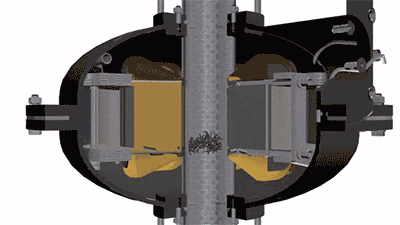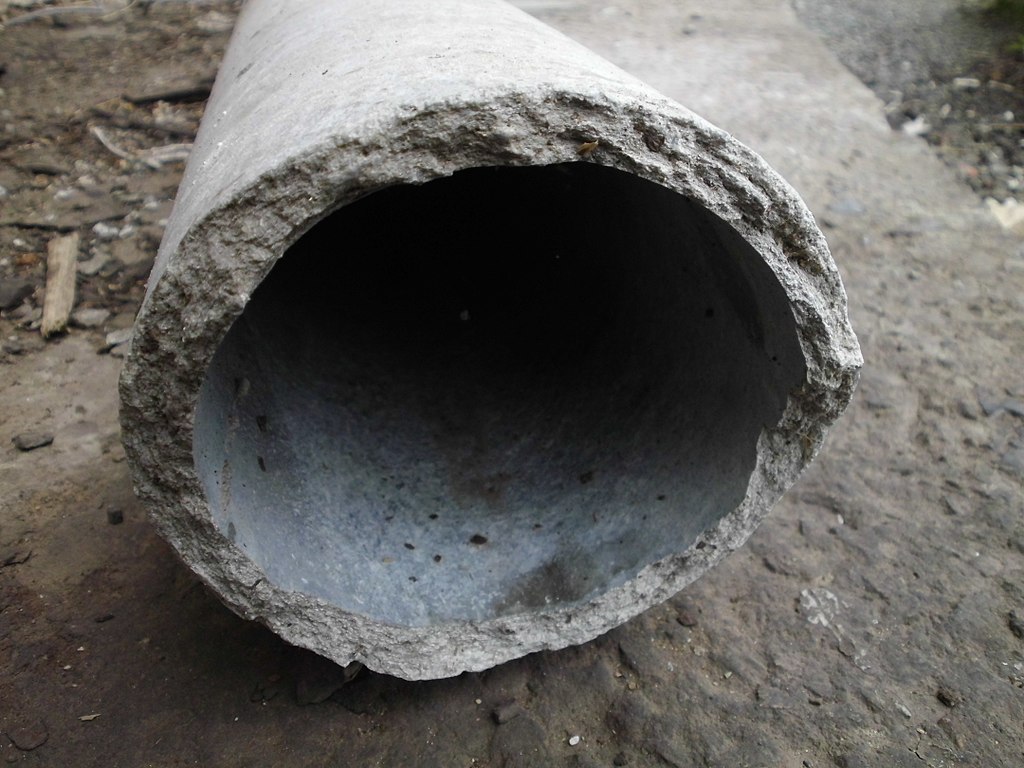Asbestos cement is an artificial, reinforced cement material used in roofing, finishing, utility system development, and other construction areas. Asbestos acts as a reinforcing fiber, and Portland cement acts as a binder therein. The manufacture of asbestos-cement products involves preparation of asbestos and subsequent mixing thereof with water and cement. After that, blanks are molded, structural components, as well as finishing and roofing materials are created using the prepared suspension or mass.
Application, advantages and disadvantages of asbestos cement
Asbestos cement is used for manufacture of construction products, building structures and materials. The most popular ones include:
- asbestos sheets or slate;
- flat, smooth, or textured slabs for cladding the structures and walls;
- wall and roof panels with heat insulation;
- inexpensive pipes for sewers, chimneys;
- asbestos cords used in heat insulation of equipment and pipelines.
This is an affordable and popular mass market material that does not lose its relevance even upon the availability of alternatives, because it is several times cheaper than they. At the same time, it is characterized by high thermal and chemical resistance, withstands the influence of aggressive media, and lasts longer than metal products, since it is not prone to corrosion.
However, the material is amenable to brittle failure; it is afraid of impacts and point loads. The best strength indicators can be achieved by improving the technologies for manufacture of asbestos-cement products which will allow increasing the activity of ingredients and creating a stabler and strong material.
Let us discuss the special aspects of manufacturing the asbestos-cement products by classic methods and the ways to improve them using a vortex layer device (AVS) from GlobeCore.
Manufacture of asbestos-cement products — conventional approaches
There are three methods for manufacture of asbestos-cement products. The dry method involves making them from the mixtures slightly moistened at the final stage of material compaction. In the semi-dry method, the pasty mixtures moistened to 50–60% are used. And in the event of wet technology, suspensions with the concentration of not more than 20% are applied.
The difference between the methods is mainly associated with the procedure for asbestos crushing and mass formation in dry, wet, and semi-dry media. The wet method of manufacturing the products from suspensions is particularly popular.
The classic design scheme is as follows:
- Asbestos mixture formulation
Several grades of material are mixed. The proportions are developed depending on the product manufactured. For example, asbestos grades 5 and 6 are used in equal amounts for roofing materials. Moreover, the soft texture shall not exceed 50%. And the share of M-60-40 asbestos may be no greater than 15%.
- Asbestos crushing
The most important operation to increase the adsorption capacity of the material. Most often, edge runners are engaged at the first stage of crushing. Roller machines are applied as well. The equipment is used to make the bundles pliant for loosening the bonds between the fibers and for separating them. Next, turbulent flows of air or liquid are used to separate the finest fibers. The product is ground with finger-type disintegrating mills or cutter drums in hollanders. When applying the wet method of manufacture, a suspension is prepared.
- Mixture preparation
Asbestos is mixed with cement and water. When the wet method is applied, it takes place directly in the hollander where the asbestos was ground. After dispersing for 10 minutes, the cement is fed into the device, and processing is continued. The cement is adsorbed onto the fibers. It is also possible to use turbomixers at this stage. In the event of extrusion technology, batch-type concrete mixers are applied as well.
- Molding of products
A whole range of operations to obtain a semi-finished product. The mass is filtered from suspensions; blanks are made using the pressing equipment, sheet-forming, pipe-molding, roller machines, and format drums. Excess moisture is evacuated by means of vacuum boxes.
- Hardening of molded products
First, preliminary hardening that makes it possible to continue handling the products is carried out. They are not ready for transportation yet. Mechanical processing and painting are performed. At the final stage, the products harden once and for all after which they are kept in storage.
Basically, the quality of products depends on the stages of asbestos crushing and mixture, suspension preparation. In this respect, the substances shall be ground, activated, they must be thoroughly mixed, and a homogeneous mass must be formed. A whole range of machines — edge runners, hydrocrushers, turbomixers, disintegrators, bucket mixers, etc. — is used for grinding and activating the products in a conventional way. The design scheme looks complex, and the line based thereon requires a lot of space and resources.
As a rule, such equipment is not distinguished by the best efficiency, and when necessary, one has to spend a lot of time and energy on the technological process, to perform operations in stages rather than all at once for obtaining a high-quality product.
The use of a vortex layer device (AVS) from GlobeCore will help in solving the problems of conventional technologies for manufacture of asbestos-cement products, improving the quality of products upon achieving higher strength properties thereof, and simplifying the design scheme to a considerable extent.
The use of a vortex layer device in the manufacture of asbestos-cement products
The preparation of mixtures for asbestos-cement products by means of AVS involves not only mixing the ingredients, but also processing them in order to ensure activation in an electromagnetic field.
How does it work?

This environment is conducive to intensification of grinding, activating, and mixing the particles to form a homogeneous, stable, reacted mixture, suspension, or pasty mass. All of these features are required to obtain a material with high strength, reliability, and endurance. Furthermore, the listed processes consume less time and energy in AVS compared to the conventional methods for manufacture of asbestos-cement products.
Special aspects of using AVS
It is relevant to apply a vortex layer device with the semi-dry and wet methods for manufacture of asbestos-cement products, using it instead of edge runners for сrushing the asbestos, mixing it with water and cement, and activating the substances. Moreover, all these processes can be carried out simultaneously by means of AVS. In the event of dry manufacture of asbestos-cement products, AVS is used for crushing the asbestos and mixing it with sand and cement. At the same time, efficient cement and sand activation influenced by a range of processes is observed.
When materials are processed in AVS, they are additionally ground to a finely dispersed state, and the specific surface area where active centers are formed increases. The latter ensure high-quality interaction of the ingredients with one another.
Sand activation is accompanied by the cleavage of Si-O bonds, the formation of active centers and free radicals. Excess energy evolves on the surface ensuring the reactions with other components. Cement activation also occurs due to processing in the electromagnetic field environment which intensifies the process of grinding the material and increasing the specific surface area thereof. It has been proven experimentally. The results are shown in Table 1.
Table 1 – Cement activation in a vortex layer device
| Time of processing in AVS, min. | Specificsurface area, cm2/g | Normal consistency | Setting time, min. | Activity,
σс·10-5, Pa |
|
| Start | End | ||||
| 0 | 3,080 | 0.330 | 1–05 | 1–25 | 246 |
| 10 | 4,965 | 0.335 | 0–55 | 1–05 | 472 |
| 20 | 5,477 | 0.382 | 0–54 | 1–19 | 477 |
| 30 | 6,724 | 0.392 | 1–15 | 1–41 | 388 |
As we can see, cement processing in AVS-100 vortex layer device for 10–20 minutes particularly affects the activity of the material. Subsequently, increased specific surface area without upward activity is better observed. Furthermore, processing makes it possible to change the cement setting time value.
At the same time, the substances are actively mixed forming a homogeneous, stable mixture which is another critically important aspect in the manufacture of high-quality asbestos-cement products.
Advantages of manufacture of asbestos-cement products using AVS
A vortex layer device is an efficient and multitasking unit for performing several processes at once as part of manufacture of asbestos-cement products. At the same time, GlobeCore equipment is distinguished by the following features:
- High efficiency
Good indicators of asbestos crushing, cement and sand activation are achieved. The mixture is distinguished by high quality and homogeneity.
- Practicability
The device can be easily integrated into the existing line for manufacture of asbestos-cement products having simplified and facilitated it.
- Cost-effectiveness
One of the main advantages of the unit is technological process optimization not only by reducing the energy consumption, but also by intensifying the processes which saves time.
- Versatility
It can be used with dry, wet, and semi-dry methods for manufacture of products.
Moreover, due to their compactness and weight, AVS-100 and AVS-150 vortex layer devices from GlobeCore require no additional structures and pedestals. Installation and operation of the equipment are plain and simple. The models are suitable for both a small workshop for manufacture of construction materials and a large-scale factory. For seeking advice and ordering a vortex layer device, please contact GlobeCore sales representatives.



